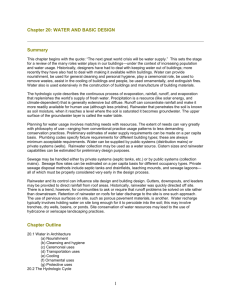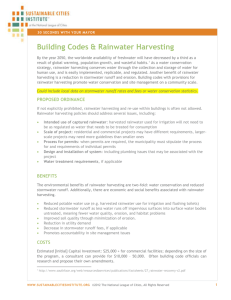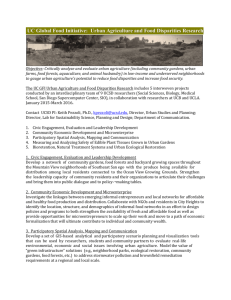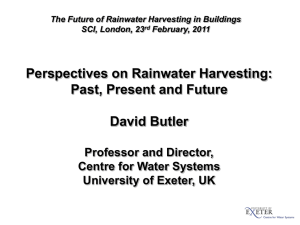Kristen Balschunat Groundwater Hydrology Final Paper 12/3/13
advertisement
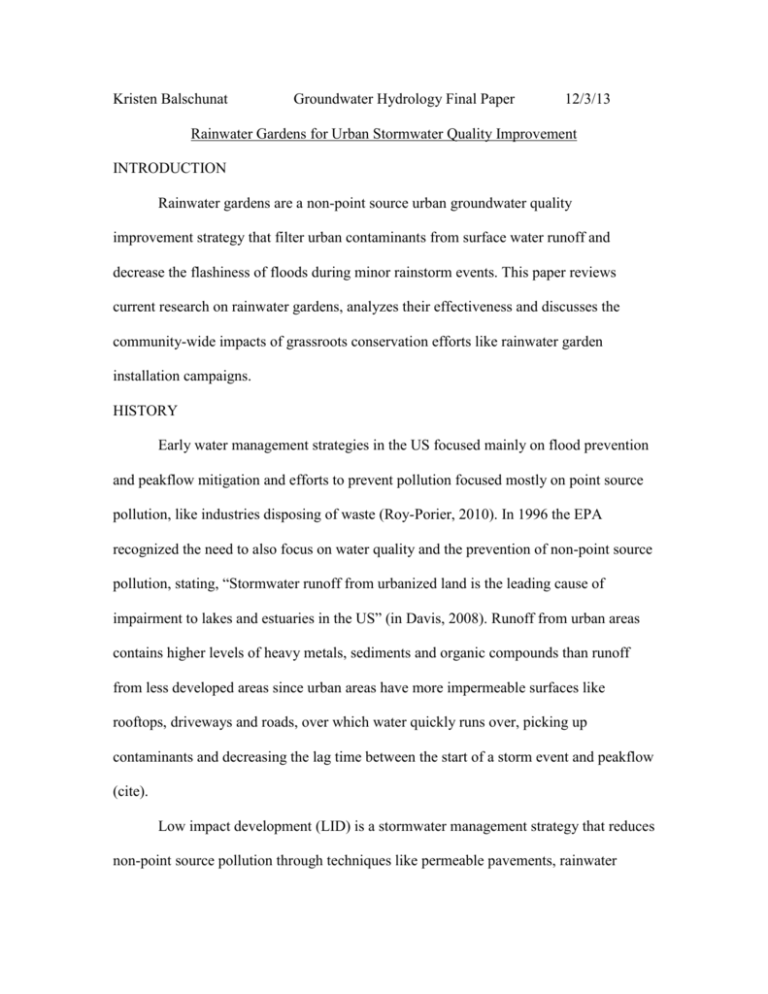
Kristen Balschunat Groundwater Hydrology Final Paper 12/3/13 Rainwater Gardens for Urban Stormwater Quality Improvement INTRODUCTION Rainwater gardens are a non-point source urban groundwater quality improvement strategy that filter urban contaminants from surface water runoff and decrease the flashiness of floods during minor rainstorm events. This paper reviews current research on rainwater gardens, analyzes their effectiveness and discusses the community-wide impacts of grassroots conservation efforts like rainwater garden installation campaigns. HISTORY Early water management strategies in the US focused mainly on flood prevention and peakflow mitigation and efforts to prevent pollution focused mostly on point source pollution, like industries disposing of waste (Roy-Porier, 2010). In 1996 the EPA recognized the need to also focus on water quality and the prevention of non-point source pollution, stating, “Stormwater runoff from urbanized land is the leading cause of impairment to lakes and estuaries in the US” (in Davis, 2008). Runoff from urban areas contains higher levels of heavy metals, sediments and organic compounds than runoff from less developed areas since urban areas have more impermeable surfaces like rooftops, driveways and roads, over which water quickly runs over, picking up contaminants and decreasing the lag time between the start of a storm event and peakflow (cite). Low impact development (LID) is a stormwater management strategy that reduces non-point source pollution through techniques like permeable pavements, rainwater collection barrels, green roofs, cut curbs, bioretention basins and rainwater gardens (Hood, 2006, Chang, 2010). According to Roy-Porier (2010), “Bioretention systems consist of small areas which are excavated and backfilled with a mixture of highpermeability soil and organic matter designed to maximize infiltration and vegetative growth and are covered with native terrestrial vegetation.” Rainwater gardens are usually smaller than bioretention basins, but employ the same principles. Runoff is directed from a rooftop into a sunken garden that is filled with gravel, sand, organic material and native plants so that it can slowly percolate into the groundwater system and be filtered of contaminants by the plants and sediments. Rainwater gardens in residential areas should be built at least 10 feet away from the house and away from any underground infrastructure like pipes. Rainwater gardens are usually built into a slightly sloped hill, so the ground is leveled and then dug 6-8 inches deep to collect water. Small-scale rainwater gardens sometimes have a gravel or sand layer below the plants, but it is often unnecessary (Native Plant Society, 2005). Larger bioretention basins always have additional filtration layers below the soil. Determining the plants to put in the garden depends on the local soil, sun availability and types of native flora. Plants that thrive in wetter environments are recommended. A rainwater garden can be a beautiful landscaping feature as well as a tool for water quality conservation. It can even increase biodiversity in urban areas and promote native vegetation (Kazemi & Beechman, 2010). RESEARCH Much research has been done in the last 5 years to evaluate the effectiveness of rainwater gardens and bioretention basins in the field and on a larger landscape scale. Trowsdale and Simcock (2011), found that a bioretention pond build next to a busy road smoothed out storm hydrographs in all 12 cases of rainfall events that took place over the study period. It effectively filtered TSS and zinc and was most effective during small rainstorm events during which water had more time to infiltrate. Davis (2008) also found that bioretention systems worked best during small rainstorm events. Endreny and Collins (2008) used a model to determine the long-term impacts of rainwater gardens and found that over time groundwater mounding can interfere with subsurface infrastructure like sewers, especially if they are not properly planned. James (2012) used GIS to model the impact of bioretention basins on a watershed scale instead of just a single site. The author determined that although bioretention basins do not decrease annual outflow volumes significantly, they do reduce peak flow volumes for single storms, sometimes even lower than predevelopment conditions and should be part of an integrated strategy for water management. The author suggested creating bioretention basins and rainwater gardens in only the most impermeable urban areas to concentrate and save resources. Hunt (2012) found that, over time, rainwater gardens effectively change runoff to ET, filter phosphorus and nitrogen and reduce the impact of heat pollution through infiltration. CHALLENGES & CRITICISMS Roy-Porier (2010) identified many challenges associated with rainwater gardens. First, it is difficult to motivate homeowners to invest in the creation of rainwater gardens and to properly maintain them. There can also be issues with construction methods, especially if there is too much compaction. Different garden sizing regulations exist in each state, so properly designing the garden can be a challenge. Also, concerns exist about the accumulation of oils, heavy metals and other contaminants in the plants and sediments in a rainwater garden. In highly polluted areas, the plants and soils may need to be periodically removed and properly disposed of. In areas with high TSS, grains can block infiltration pores over time and decrease the permeability and efficiency of a rainwater garden. COMMUNITY BENEFITS Perhaps the greatest benefit of promoting rainwater gardens is engaging community members in the conservation of their local water quality. Building a rainwater garden involves developing watershed awareness, understanding local soils and climates, researching native plant species and collaborating with neighbors and experts to put the project into place. It also gives people a sense of pride in their local environment. As one publication asserts, “You are about to embark on a journey that can improve the future of your state!” (Chesapeake Bay Foundation, 2003). Other publications describe how to plan and build rainwater gardens in New Jersey (Native Plant Society, 2005), Wisconsin (Bannerman, 2003) and Washington (Hinman, 2003). These publications tend to over exaggerate the benefits of rainwater gardens on regional hydrology, but also provide accessible knowledge for the public about hydrologic systems and the role that individuals play in maintaining overall water quality. CONCLUSION In conclusion, rainwater gardens cannot solve all urban water quality and peakflow issues, but they should be part of a multi-faceted LID water management strategy in urban areas. BIBLIOGRAPHY Bannerman, R., & Considine, E. (2003). Rain gardens: A how-to manual for homeowners. University of Wisconsin Extension. Retrieved from: http://learningstore.uwex.edu Chang. N. (2010) Editorial: Hydrological conncetions between low-impact development, watershed best management practices and sustainable development. Journal of Hydrologic Engineering, June 2010, 384-385. Chesapeke Bay Foundation. (2003). Student BaySavers Projects: Build Your Own Rain Garden. Davis, A. P. (2008). Field performance of bioretention: Hydrology impacts. Journal of Hydrologic Engineering, 13(2), 90-95. Endreny, T., & Collins, V. (2009). Implications of bioretention basin spatial arrangements on stormwater recharge and groundwater mounding. Ecological Engineering, 35, 670-677. Hinman, C. et. al. (2013) Rain garden handbook for western Washington: A guide for design, installation and maintenance. Washington State University Extension. Retrieved from: https://fortress.wa.gov Hood, M., Clausen, J.C., & Warner, G.S. (2006). Low impact development works! Journal of Soil and Water Conservation, 61(2), 58a-61a. Hunt, W.F., & Davis, A.P., Traver, R.G. (2012). Case study: Meeting hydrologic and water quality goals through targeted bioretention design. Journal of Environmental Engineering, 138(6), 698-707. The Native Plant Society of New Jersey. (2005). Rain garden manual for New Jersey. Retrieved from: www.npsnj.org James, M. B., & Dymond, R. L. (2012). Bioretention hydrologic performance in an urban stormwater network. Journal of Hydrologic Engineering, 17(3), 431-436. Kazemi, F., Simon, B., & Gibbs, J. (2011). Streetscape biodiversity and the role of bioretention swales in an Australian urban environment. Landscape and Urban Planning, 101, 139-148. Roy-Porier, A., Champagne, P., & Filion, Y. (2010). Review of bioretention systems research and design: Past, present and future. Journal of Environmental Engineering, 136 (9), 878-889. Trowsdale, S.A., & Simcock, R. (2011). Urban stormwater treatment using bioretention. Journal of Hydrology, 397, 167-174.

